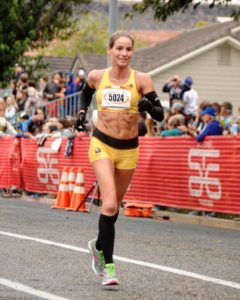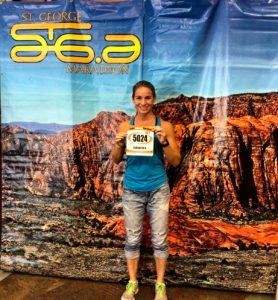This is my second blog regarding St. George Marathon. If you’re looking for the one regarding logistics, race course, etc – go back an entry and you’ll find all that fun stuff there. This blog is going into the personal side, my experience 100% as a human, an athlete, and a gal with a big goal. **Fair warning: if abortion or topics of that nature make you uncomfortable or mad, please stop reading now – because I am going deep on this one.

Pre-race. Full of big dreams and optimism.
My training for Saint George was overall really great. I gave myself a solid 18-week plan, peaked at 70-mile weeks, and was determined to feel like the elite bib I’d have strapped to my chest was one thousand percent deserving. I did have some aches and pains through training, and I was quick to address them. With Saint George being my 20th marathon, I’ve learned over the years that its best to be undertrained and healthy than overtrained and held together by KT tape, crossed fingers and a wish. Going into the taper, I knew I’d done everything right, and it was simply about executing the plan. There was only one thing that made me nervous: my race day fueling. With having the opportunity to have my own personal bottles at the elite tables, I’d overhauled my fueling and switched to Maurten for some of my long runs. Honestly, I had mixed experiences.

Attempting to smile with Chris through tears of disappointment.
Some runs had felt fine, and others had me a bit nauseated. But I felt I should abandon my gels and use this opportunity to perhaps make improvements. After all, many of the top marathoners in the world swear by Maurten.
Race morning turned out to be a complete mess after mile 6 or 7. For the final 19-20 miles, I was essentially ill. Vomiting, dry heaving, etc – I could hardly keep down my fuel. Even water was hard to stomach. I lost track after the 8th time I fought the next wave of nausea – but for about 2.5 hours I was in complete hell. Obviously paces suffered. The odd thing was that my heart rate felt incredibly high at one point and impossible to regulate – even on the smooth downhills. I assumed it was the Maurten – my fueling choice backfired and cost me my race. I crossed the finish line in 3:11 – a solid 11+ minutes off my goal. I was so mad at myself. Physically in destress. Mentally, I questioned everything. After all, I had 2.5 hours to suffer and question my choices, my training, my potential – like, was my goal just simply outside my potential? I burst into tears at the finish line. Not the happy or emotional tears some marathoners experience, but tears of devastation, pain, frustration, and doubt.
Incredibly long story short – 36 hours after the marathon, I took a pregnancy test. I have an IUD, so the assumption was that there’s no way I’m pregnant. But I was a few weeks late (it’s happened with training before), and my nausea hadn’t subsided. It turns out my IUD had slipped (apparently this can happen!), rendering it useless, and I ran the marathon 6-weeks pregnant. Pregnancy with an IUD is often dangerous, as an ectopic pregnancy is common with an IUD and the female can bleed out. So off to the ER we go, in Utah, 36 hours post-marathon, to see if I was ectopic. Thankfully, because the IUD had slipped (irony, I know), it wasn’t ectopic and so I could pause, process and still attempt to enjoy a few days in the Southwest. Chris and I both were on the same page with not wanting to keep it, and so I scheduled an abortion for the day after we’d fly back to NYC. We attempted to enjoy the rest of the trip – though I was often nauseas, exhausted, and experienced blurred vision.

In the ER in Utah and having an ultrasound done to determine if it was ectopic or not.
Planned Parenthood in NYC treated me with nothing but kindness and respect. I elected with the in-clinic procedure. Being only 6-weeks pregnant, I was told it would be a simple and easy procedure with minimal recovery. Chris came with me and waited in the lobby for 4+ hours, and then took me home after. I was groggy, a little uncomfortable, but otherwise feeling okay. In the days following, I cramped and bled a bit. I felt weak and tired. I was told to expect 2-3 weeks of bleeding and cramps, and that it may take longer for hormone levels to essentially go back to normal. (Side note: hormones are insane. My boobs literally doubled in size in a matter of days. Blurred vision was also due to hormones and blood pressure.)
As you can imagine – it’s been one hell of a ride. Between the marathon 4 weeks ago, the abortion 3 weeks ago, I am still recovering. Mentally and emotionally I am 100% at peace with the abortion. It wasn’t a decision I struggled with. But mentally I am still processing the marathon. I’m sure it sounds silly considering the circumstances, but I put my heart, soul, blood, sweat and tears into that race – and it was a painful failure. Just today, I told Chris I still am questioning my abilities. My confidence is shook, big time. And I need to deal with that. I have had overwhelming support from friends, family and complete strangers via social media. I am so grateful. Physically, I feel great after the marathon. It’s now been 4 weeks. Recovery from the abortion has been the harder, more painful and frustrating part. But I’m trying to be patient and to take care of myself.
Being an athlete is tough. Being a female is tough. Being a female athlete is something I’m struggling with. I want women to know that they aren’t alone – be it a disappointing race, a miscarriage, an abortion, a loss of a loved one – these tough life moments happen to all of us. It’s my hope that over time we can feel supported, empowered, and inspired by each other to keep climbing, to champion each other, and to always have each other’s backs.

Willing myself across the finish line.


 The long run. The cornerstone of marathon training. The weekly run that is essentially “dress rehearsal” for marathon day. It’s the run most runners stress about, and the one that over times builds confidence and endurance fitness. A marathoner cannot be prepared for race day without consistent long runs under their belt, but there’s a lot of opinions, beliefs and falsehoods regarding the long run – especially the magical peak mileage number. It’s important to understand that coaches will have their own reasons for how long they take the long runs, and (hopefully) there’s science-based factors considered. Most non-coaches toss out “20 miles” as the long run distance every marathoner should hit. But I’m going to attempt to shed some light onto the reason for the long run, what mental and physical adaptions occur, the different types of long runs, and why the 20-miler staple is actually not always the correct number. So strap in, cause here we go!
The long run. The cornerstone of marathon training. The weekly run that is essentially “dress rehearsal” for marathon day. It’s the run most runners stress about, and the one that over times builds confidence and endurance fitness. A marathoner cannot be prepared for race day without consistent long runs under their belt, but there’s a lot of opinions, beliefs and falsehoods regarding the long run – especially the magical peak mileage number. It’s important to understand that coaches will have their own reasons for how long they take the long runs, and (hopefully) there’s science-based factors considered. Most non-coaches toss out “20 miles” as the long run distance every marathoner should hit. But I’m going to attempt to shed some light onto the reason for the long run, what mental and physical adaptions occur, the different types of long runs, and why the 20-miler staple is actually not always the correct number. So strap in, cause here we go! Dear Runners, we need to talk. The statistics with runners and injuries is enough to make someone not want to lace up. However, much of the injuries runners encounter are 100% preventable. Sure, there’s a percent of runners who will be injury-prone for reasons they cannot control – one leg slightly longer than the other, a trauma from years ago, overuse from a childhood activity, and poor genetics. But that’s a small percent of runners. YOU are often responsible for those aches and pains. This isn’t about pointing blame, but informing, educating and perhaps preventing injuries in the future by making different choices.
Dear Runners, we need to talk. The statistics with runners and injuries is enough to make someone not want to lace up. However, much of the injuries runners encounter are 100% preventable. Sure, there’s a percent of runners who will be injury-prone for reasons they cannot control – one leg slightly longer than the other, a trauma from years ago, overuse from a childhood activity, and poor genetics. But that’s a small percent of runners. YOU are often responsible for those aches and pains. This isn’t about pointing blame, but informing, educating and perhaps preventing injuries in the future by making different choices. As most have heard, the weather on Patriot’s Day was anything but kind. Marathoners are pretty tough people, and Monday demanded our mental strength to carry when our bodies succumbed to the elements. I often preach to my runners that they need to learn to train in most elements because we never know what we’ll be handed by Mother Nature on race day. Monday was a reminder of that. Not surprisingly, the runners I know who preformed best were the Winter Warriors and the Ultra Marathoners.
As most have heard, the weather on Patriot’s Day was anything but kind. Marathoners are pretty tough people, and Monday demanded our mental strength to carry when our bodies succumbed to the elements. I often preach to my runners that they need to learn to train in most elements because we never know what we’ll be handed by Mother Nature on race day. Monday was a reminder of that. Not surprisingly, the runners I know who preformed best were the Winter Warriors and the Ultra Marathoners. My calves felt like they were on the verge of cramping due to the cold around mile 14. I did everything I could to prevent cramping from happening, which meant changing my stride, form and pace in the late miles. I knew I was better off adding a minute to each mile than cramping and needing walk and stretching breaks in the elements. At the finish, I could barely lift my legs. My hips were in incredible pain, so cold and tight, and I wasn’t confident I’d make it to my hotel without a wheelchair ride to medical. Marni and the cup of hot cocoa at the finish line were the only reason I didn’t end up in a wheelchair.
My calves felt like they were on the verge of cramping due to the cold around mile 14. I did everything I could to prevent cramping from happening, which meant changing my stride, form and pace in the late miles. I knew I was better off adding a minute to each mile than cramping and needing walk and stretching breaks in the elements. At the finish, I could barely lift my legs. My hips were in incredible pain, so cold and tight, and I wasn’t confident I’d make it to my hotel without a wheelchair ride to medical. Marni and the cup of hot cocoa at the finish line were the only reason I didn’t end up in a wheelchair.


